|
|
|
Meditation Seeking Understanding ~ Flesh
These pages are meditations on the mysteries of the creation, the incarnation, and the redemption. They explore the Christian understanding that all men and women are consubstantial in one and the same human nature, and are consubstantial with Jesus Christ as to his humanity. The meditations are based on a layman's reading of the Sacred Bible, the Catechism of the Catholic Church, and the Theology of the Body as they pertain to the egalitarian complementarity of man and woman, which transcends the patriarchal binary of mutually exclusive male-female opposites. This understanding of the complementary equality of man and woman applies to all the sacraments, sheds light on the great nuptial mystery of Christ and the Church, and would seem to support the ordination of women to the ministerial priesthood and the episcopate.
|
Natural Complementarity of Man and Woman
Working Draft - 6 May 2016
PRAELUDIUM
|
In the Catholic Church, the resistance to the ordination of women is rooted in a sacramental theology that conflates the patriarchal gender binary with biblical revelation. This is a meditation on human nature, male and female, as it pertains to the sacramental priesthood of the New Law when unconstrained by the patriarchal priesthood of the Old Law. This is a visceral issue that cannot not be settled by reasoning alone. This page attempts to support prayerful discernment by stepping outside of the patriarchal box and reconsidering the issue in light of the deposit of faith and the signs of the times.
On the mystery of God becoming flesh in Mary of Nazareth:
"The Lord came to her
to make himself a servant.
The Word came to her
to keep silence in her womb.
The lightning came to her
to not make any noise.
The shepherd came to her
and the Lamb is born, who humbly cries.
Because Mary's womb
has disturbed all the roles:
The one who created all things
wasn't born rich, but poor.
The Almighty came to her,
but he came humbly.
Splendor came to her,
but dressed in humble clothes.
The One who gives us all things met hunger.
The One who gives water to everyone met thirst.
Naked and unclothed he came from her,
he who dresses all things with beauty."
Hymn "De Nativitate" 11:6-8
St. Ephrem the Syrian (4th Century CE)
|


Mary Ward
(1585-1645)
|
Acronyms and Links:
|
CREATION

Adam and Eve: Embodied Humanity, Same Flesh, Sexual Differentiation, Egalitarian Complementarity
Genesis 1:26-27; 2:7, 22-24; 3:16; 5:1-2; John 1:14; Galatians 3:28; CCC 371, 372, 383; TOB 2:4, 3:2, 4:2, 8:1, 8:4, 9:1-5, 10:1, 19:4, 70:7, 72:5
Image: Ministry to Children (CC)
Point 1: In the beginning, man and woman were created as rational living beings composed of body and soul in the unity of the same flesh. Thus having a body, as well as having a soul, is more fundamental for human personhood than being male or female. All human beings, male and female, are consubstantial, i.e., share one and the same human nature. All created men and women are naturally homogeneous, not only somatically but also pyschologically and in their whole being. The complementarity of man and woman does not cancel their full equality as human persons. The egalitarian complementarity of man and woman is ordered to the communion of persons in God's image, not to male domination and female submission as in the patriarchal binary that emerged from original sin but has been superseded by the redemption.
Point 2: The human being is a body, and thus any bodily trait, such as sex, is constitutive of the person. The body is not determinative, however, because the personal subject is a body but is not only a body: a human person is a body animated by a soul, a "body-soul." Each and every human person is a body-soul, a unique instantiation of imago Dei; all humans are consubstantial, of the same flesh, of the same nature. This unity that subsists in diversity, sexually and otherwise. The somatic homogeneity of man and woman means that sexual differentiation, while undoubtedly being a gift, is also a limitation of embodied human nature. Thus a man cannot be a mother, and a woman cannot be a father; a man is a man, and a woman is a woman, but they are both equally human. There is no such thing as two different human natures. The body is male or female; humanity is male and female.
Point 3: Any sacramental theology that makes sexuality determinative (rather than just constitutive) of a person, human or divine, is based on an inadequate anthropology. The body is a sacrament of the entire person, but is not the entire person. If this is true for every human person, even more so for Jesus Christ, who is a divine person. The Son of God is "eternally begotten," not created, and did not become a body until the incarnation, at which time the concrete totality of human nature was assumed and the Son of God became embodied as the Son of Man, "like us in all things but sin." Sex is more deeply constitutive of the human person than other, more superficial traits such as skin color, but it is a created attribute that does not subsume the entire person as a body-soul. It follows that, for the redemption and the sacramental economy, the masculinity of Jesus is as incidental as the color of his eyes.
In biblical language, "flesh" means "human being." The man and the woman are of the same flesh: different physical characteristics, same personhood. For this reason, in the TOB, the "male or female" descriptor is always used in reference to the human being as a body, while "male and female" is always used in reference to the human being as a person.
|
INCARNATION
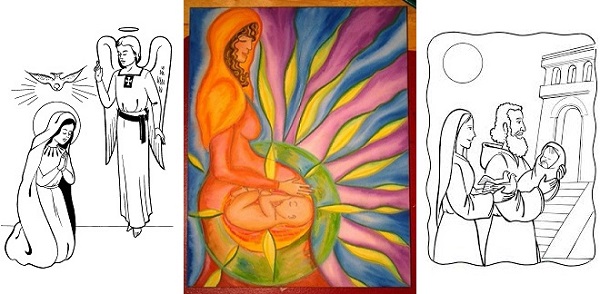
Mystery of the Incarnation: The Eternal Word Assumes Human Nature in the Flesh, in a Body
Luke 1:38, 2:4-7, 2:21-24; John 1:14; Galatians 4:4; Ephesians 5:27; CCC 773, 973; TOB 5:5-6, 6:3, 8:1, 9:4, 10:1, 13:1, 14:3-4, 19:4, 21:5-6; 22:5, 23:5, 25:5, 46:4, 97:2, 102:4, 122:5, 123:8, 124:3, 125:5, 126:2, 133:1-2
Image: Living Water Art
Jesus is the "Son of Man," but was the divine "Son of God" a male before the incarnation? For the redemption and the sacramental economy, is the human masculinity of Jesus more important than the color of his eyes?
Point 1: God assumed human nature when Mary accepted her unique vocation to be the mother of Jesus. In Mary, the Eternal Word became flesh, as flesh of her flesh. Thus Mary preceded the entire sacramental economy. She who had never been baptized, by her fiat became the Mother of God. In Mary, the Old Law was fulfilled by being turned upside down and inside out. In her womb, the omnipotent God became the most vulnerable Servant of the New Law. The Holy Family was not a patriarchy, thus revealing that the Holy Trinity is not a patriarchy. Jesus would never identified himself as a patriarch, thus revealing that his spousal love for the Church is not essentially patriarchal. Jesus Christ is head of the Church because he is a divine Person and our Redeemer in the flesh, not because he is a human male. Mary is the type of the Church, the type of humanity; she is the sinless bride that preceded sinful humanity, and a Church of baptized sinners, in the nuptial communion of the sacramental economy.
Point 2: In the TOB, the term constitutive refers to the somatic constitution of the body. Since a human person is a body, every somatic trait is constitutive of the human person; but just as there is a sex/gender continuum, there is a continuum of human psychosomatic traits, sex being the most profound, others being more superficial such as race, skin color, etc., but none being determinative of the person. What is determinative? The first human person was created by "an act of enlivening matter by the spirit" (TOB 70:7, 72:5). This "animation of the body" is what determines that a body made of dust becomes a body-person, a living soul. So the TOB explicitly recognizes that the "homogeneity of the whole being" of man and woman, made of the same flesh and fully consubstantial in human nature, precedes and transcends all psychosomatic differences, including sex and, of course, gender.
Point 3: Could this be the reason that Jesus refers to his body, his flesh, his blood, but never to his masculinity or any other particularity of his human constitution? We know that Jesus is a divine Person with two natures, divine and human. Would it be right to think that any of his embodied particularities, including his sex/gender, is determinative of a divine Person? Jesus is the Son of Man, but was the Son of God a male before the incarnation? It is significant that Hebrews 10:5, John 6:56, and other New Testament texts about Jesus' identity, always refer to body, flesh, blood, but nothing is said about his masculinity. So, what is the binary significance of Jesus' masculinity for the sacramental economy?
The eternal Word, "eternally begotten," became flesh, in a human body, by an act of God, not by an act of man, even though Mary was the consenting "handmaid of the Lord." It was no accident that he was born a male under the Old Law, in a patriarchal society, for God comes to us where we are; but for this reason, his masculinity is utterly incidental for the redemption and the sacramental economy.
|
REDEMPTION
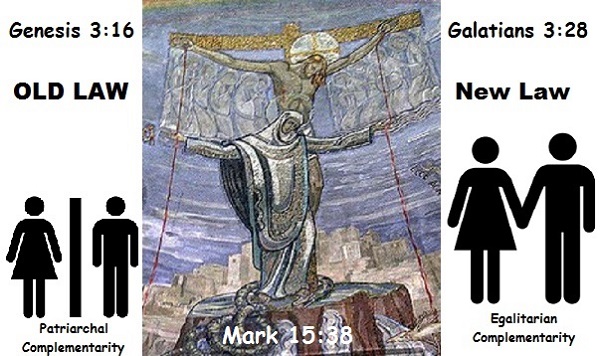
One Flesh, Man and Woman, God and Humanity, Redeemer and Redeemed
Genesis 1:27, 2:7, 2:24, 3:16; Mark 15:38, 16:3; Luke 2:35, 40, 52; John 4:27, 16:12-13, 19:25; 1 Corinthians 15:45; Galatians 3:28; CCC 26ff, 1066ff, 1691ff; TOB 8:1, 9:4, 13:1, 28:4, 31:2, 32:2, 40:1-2, 41:2, 43:3, 47:2, 48:4, 61:4, 62:1, 76:5, 116:4
Image: Interfaith Mary Net
Point 1: All the mysteries of the life of Christ, from the Annunciation to the Ascension, are made visible in the flesh of a concrete human being, Jesus of Nazareth, who lived in one place, at one time, in one family, in one culture. He grew up as the son of his parents, worked for a living, went around doing good and planting the seeds of the God's kingdom as best he could, challenged his culture without imposing anything that people could not understand, had male and female friends who became disciples, had male and female detractors, and died as a servant king but rose as the Servant King.
Point 2: Jesus chose celibacy for the sake of the kingdom and by choice never became a father, but would not have been able to be a mother; for sexual differentiation is a gift but also a limitation of the human condition. Jesus was God in time and space, yet like us in all things but sin.
Point 3: The first millennium of the Christian era was spent defining the Creed and the "one person, two natures" Christological dogmas. The second millennium was spent defining the sacraments and the Marian dogmas that prefigure the Church. Perhaps the third millennium will be about understanding the great nuptial mystery of Christ and the Church, and further embracing the tripod of redemptive fruits he gained for us: the transition from the Old Law to the New Law, the emancipation from all forms of slavery, and the restoration of male-female communion. But the patriarchal binary is the stone that still blocks the entrance to the tomb, and this imbalance of male domination and female submission must be corrected during the "already, but not yet" time window of the pilgrim Church that goes from Pentecost to his second coming in glory.
Before the redemption, under the patriarchal Old Law, human development was constrained by rivalry between man and woman. After the redemption, under the New Law, integral human development can flourish in the restored unity of man and woman. But there is no such thing as integral human development in Christ that is exclusively male or exclusively female. In our "already/not yet," it is time to give top priority to the third leg of the Pauline tripod!
|
NUPTIAL COVENANT
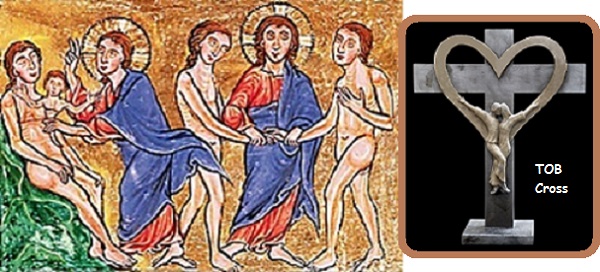
One Flesh, Nuptial Communion of Christ and Church, God and Humanity
Genesis 1:27, 2:7, 2:24, 3:16, 5:1-2; Matthew 16:19, 18:18, 19:4-5; Acts 15:28; Ephesians 5:21-33; CCC 796, 802-810, 1616; TOB 1:3, 2:1, 8:1, 8:4, 9:4, 13:1, 14:4, 15:5, 16:1-5, 17:2, 18:4-5, 19:5, 22:6, 23:5, 25:2, 31:1, 32:4, 33:3, 37:6, 49:6, 58:6, 66:2, 87:2-3, 91:1, 93:6, 97:2, 99:2, 102:1, 130:5, 132:2
Images: Piotra Skargi Institute, TOB Cross by Timothy Schmalz
Point 1: When Jesus gave the power of the keys to Peter, he was submitting to the will of the Church on earth. This is a great mystery (mysterium magnum) and may be the most beautiful and most misunderstood mystery of the Christian faith. He who is Priest, Prophet, and King, as well as Victim, voluntarily entrusted the continuation of his mission to the Church and gave her the power, wisdom, and authority to sacramentally bring the Good News to all nations.
Point 2: The old nuptial covenant between God and Israel now becomes a new covenant between Christ and the Church, who becomes one flesh with Christ and the great sacrament (sacramentum magnum) of divine mercy in this world. It is a nuptial mystery that encapsulates the primordial sacrament of male-female unity in one flesh but also reveals that there is a Christ-Church unity that points to a God-Human unity (theosis) as the ultimate goal of evangelization until the Lord returns in glory.
Point 3: The spousal meaning of the body, both the human body and the Church as the body of Christ, is by no means limited to a superficial patriarchal interpretation of the bridegroom-bride analogy. The spousal bond of Christ-Head and Church-Body radically transcends the patriarchal binary of male domination and female subordination. Jesus Christ is head of the Church because he is a divine Person and our Redeemer in the flesh, not because he is a human male. This nuptial meaning of the Christ-Church mystery as a communion of persons, in the image of the Trinity, applies to all the sacraments.
QUESTION: The human body is normally male or female, but humanity is male and female. The eternal Word was not a male before the incarnation. After the redemption, there is a radically new covenant between God and humanity, signified by the nuptial Christ-Church covenant, the mystery of the Church as the body of Christ. But, if Christ's body is heterosexual, why should his head be homosexual?
|
SACRAMENTAL ECONOMY
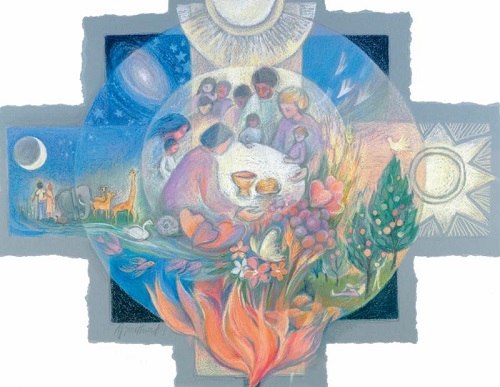
One Flesh, One Body of Christ, One Communion of Persons
Psalm 8:4–6; John 1:1-3, 14; Galatians 3:28; Philippians 2:7-8; Colossians 1:15-20; 1 Thessalonians 5:21; Hebrews 10:10; Acts 15:28; CCC 239, 242, 248, 262, 370, 467, 685, 703, 1577, 1598, 2789; TOB 1:3, 2:4, 3:2, 4:2, 8:1-4, 9:4, 13:1, 19:2-5, 21:6, 25:2, 31:3, 33:2-4, 35:5, 41:1, 58:2, 59:4, 65:3, 66:2-4, 67:3, 69:4-8, 70:5-7, 75:3, 76:5-6, 78:5, 79:9, 80:1, 81:4, 86:4, 87:5, 89:3-8, 90:1-6, 91:3, 92:6, 93:5-6, 94:5, 95:2, 95b:1, 96:5,7; 97:5, 99:2, 102:4-7, 104:4-5, 114:8, 115:6, 116:5, 117:5, 117b:2, 6, 121:1-3, 122:1-2, 123:7, 124:1, 126:2, 129:2-5, 130:5, 133:3
Image: Mary Southard - Ministry of the Arts
Points to be considered:
HEAD & BODY ~ Our Lord Jesus Christ is the head of the Church because he is a divine Person and our Redeemer in the flesh, not because he is a human male. Any baptized person, male or female, can be ordained to act in persona Christi capitis.
UNITY IN DIVERSITY ~ All humans, and therefore all the baptized, are somatically homogeneous and consubstantial in their whole being, their redeemed bodies being of the same flesh and making visible their souls as images of God; and their fundamental unity in one and the same human nature, and equality in personhood, subsists intact regardless of sexual differentiation or any other pyschosomatic diversity.
BODY SACRAMENTALITY ~ For the redemption, what matters is that God assumed a human body ("This is my body"). Sexual differentiation is a gift but is also a limitation of the human condition. Jesus is "like us in all things but sin". For the sacramental economy, the masculinity of Jesus is as incidental as the color of his eyes. This applies to all the sacraments, including the ministerial priesthood. The exclusively male priesthood is patriarchal heritage received from the Old Law that has yet to be discarded under the New Law.
HUMAN LANGUAGE ~ "God is Love." "God the Father" is not exclusively male. "God the Son" was the Eternal Word before the incarnation, and not exclusively male. "God the Holy Spirit" is not exclusively male. The Trinity is a communion of divine persons, not a patriarchy. The Holy Family was not a patriarchy. Jesus never identified himself as a patriarch. The Church is "one, holy, catholic, and apostolic," and is the communion of all the baptized, but is not essentially patriarchal. As the family evolves from male headship to joint male-female (father-mother) headship, the patriarchal language that obscures biblical texts and magisterial teachings is becoming an obstacle to grace.
MARY THEOTOKOS ~ Mary preceded the sacramental economy, and hers was a unique and unrepeatable ministerial vocation (Mother of God) that does not preclude the ordination of baptized women. She is a human person, not a divine person. Priests and bishops are human persons, not divine persons. If a female human person can be the Mother of God, a female human person can be a member of the Church hierarchy.
THE 12 APOSTLES ~ In choosing 12 males to represent the patriarchs of the 12 tribes of Israel, Jesus was acting within the limits of his mision to patriarchal Israel and what his disciples could understand. Would Jesus make the same choice for the Church of the 21st century?
CHURCH AUTHORITY ~ The male-only priesthood is a choice the Church makes, not a dogma of the Catholic faith; and the Church, by the power of the keys, has the authority to ordain women as soon as it is recognized that the patriarchal binary is an obstacle to evangelization in a post patriarchal world. Would Jesus, in today's world, choose 12 males to represent the patriarchs of the 12 tribes of Israel?
SACRAMENTAL COMPLEMENTARITY ~ Humanity is male and female. Just as man and woman complement each other in the sacrament of marriage, they also complement each other in all the sacraments, including Holy Orders. Apostolic succession is not contingent on masculinity. Once the artificiality of the patriarchal gender binary and the naturally egalitarian complementarity of man and woman are recognized, there is absolutely no dogmatic impediment to the ordination of women to the priesthood and the episcopate.
DISCERNMENT ~ Further enriching the hierarchy with the sacramental complementarity of man and woman would be more conducive to integral human development as well as an integral ecology. The patriarchal family is passing away, and the patriarchal hierarchy of the Church is becoming an obstacle to grace and the mission of evangelization. Here and now, the ordination of women to the priesthood and the episcopate would be for the glory of God and the good of souls.
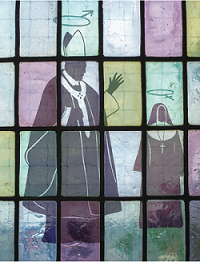
|
N.B. The dogma on the institution of the sacramental priesthood (Council of Trent) does not mention a masculinity requirement for ordination. The declaration Inter Insegnores (CDF, 1976) was a doctrinal disgrace. The edict Ordinatio Sacerdotalis (St. John Paul II, 1994) was a tragedy that is now becoming a travesty, as people are intimidated into thinking that it was an infallible definition of a divinely revealed dogma. The Catechism of the Catholic Church (#1598) plainly states that ordaining only males is a choice (first sentence) and who can make the choice (second sentence). In matters related to apostolic succession, it is time to test everything, keep what is good, and let go of what is no longer good.
(Cf. 1 Thessalonians 5:21)
|
COLLOQUIUM
This meditation does not attempt to "prove" anything. It is a personal reflection about a visceral issue that cannot be resolved by reasoning alone, and prayerful discernment of Christ's will is required. The truth is timeless, but the Church's understanding of the truth is not timeless; the faith is always the same but the Holy Spirit enables the Church to bring out of the deposit of faith what is new and what is old (cf. Matthew 13:52).
Lord, grant me the serenity to accept what I cannot change,
The courage to change what I should change,
And the wisdom to know the difference.
Mary, Mother of the Church and Untier of Knots, pray for us.
|
|Back to Title|
PelicanWeb Home Page
Index of Meditations
|
|
|
|